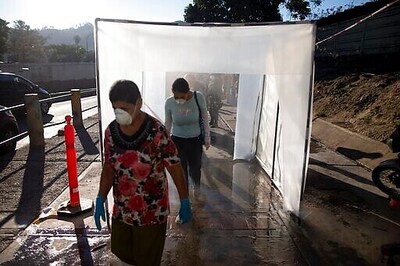
views
Delray Beach (Florida): Monica Seles's brilliant career, disrupted by a stabbing and cut short by injury, ended quietly on Thursday.
The former world No. 1 may never have fully recovered from being stabbed by a spectator during a match in 1993 but it was injuries that stopped her making a comeback, as well as a stubborn refusal to return at a level below her best.
Seles, 34, last played a competitive match at the 2003 French Open but thoughts of a comeback were never far from her mind.
"My personal theory is, if you're retired, you're retired," she told the Houston Chronicle last year.
"You don't come back. And I don't feel like I'm ready to say that. I'm in such good shape. I only wish I was in this good a shape when I was playing. It's hard to accept that, just because of an injury, you're finished."
Equally hard to accept was the fear that she may return to the court a pale shadow of her former self.
Lindsay Davenport, another former world No. 1 who made her own comeback last year, said in 2005 that she did not expect Seles to return because she would not accept lower standards.
"I think she loved her last year and won't go out there and play unless she's the good Monica that's everyone's used to," Davenport said.
Perhaps Seles, world No. 1 for a total of 178 weeks, was right.
It would have been nearly impossible to recapture her former brilliance and her nine Grand Slam titles will ensure she is remembered as one of the game's greatest players.
Born in the former Yugoslavia, Seles was among the pioneers along a path that has proved lucrative for many young players from Eastern Europe.
She moved to Florida as a schoolgirl and attended the Nick Bollettieri Academy in Florida, which was later to be home to players including Russian Maria Sharapova and Serbian Jelena Jankovic.
Explosive start Her early form on the WTA Tour was explosive, winning her first tournament in Houston aged just 15 by beating multiple Grand Slam winner Chris Evert in the final.
PAGE_BREAK
During a remarkable 1991 she reached the final of all 16 events she entered, winning 10 including the Australian, French and US Opens.
Indisputably the best player in the world and then the youngest to reach the top of the rankings, Seles was rarely comfortable in the media spotlight.
Giggly in her teens, her infamous on-court grunt upset some fans but her grit, enthusiasm and superb two-handed groundstrokes won her widespread admiration.
That turned to sympathy when German Guenter Parche thrust a kitchen knife into her shoulders as she rested during a quarter-final match at the Hamburg Open.
Parche, a fan of Seles's great rival Steffi Graf, received a suspended two-year sentence while Seles did not play for over two years.
After becoming a US citizen in 1994, she won her first tournament back, the 1995 Canadian Open.
With the mental trauma of her attack seemingly behind her, victory in the 1996 Australian Open suggested that Seles's career might take off again.
She regularly reached Grand Slam quarter-finals from 1997-2002 but only once made the final and nearly six years later, frustrated by a succession of foot injuries, Seles was finally forced to admit defeat.




















Comments
0 comment